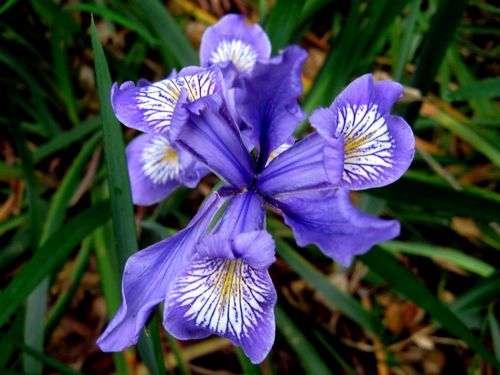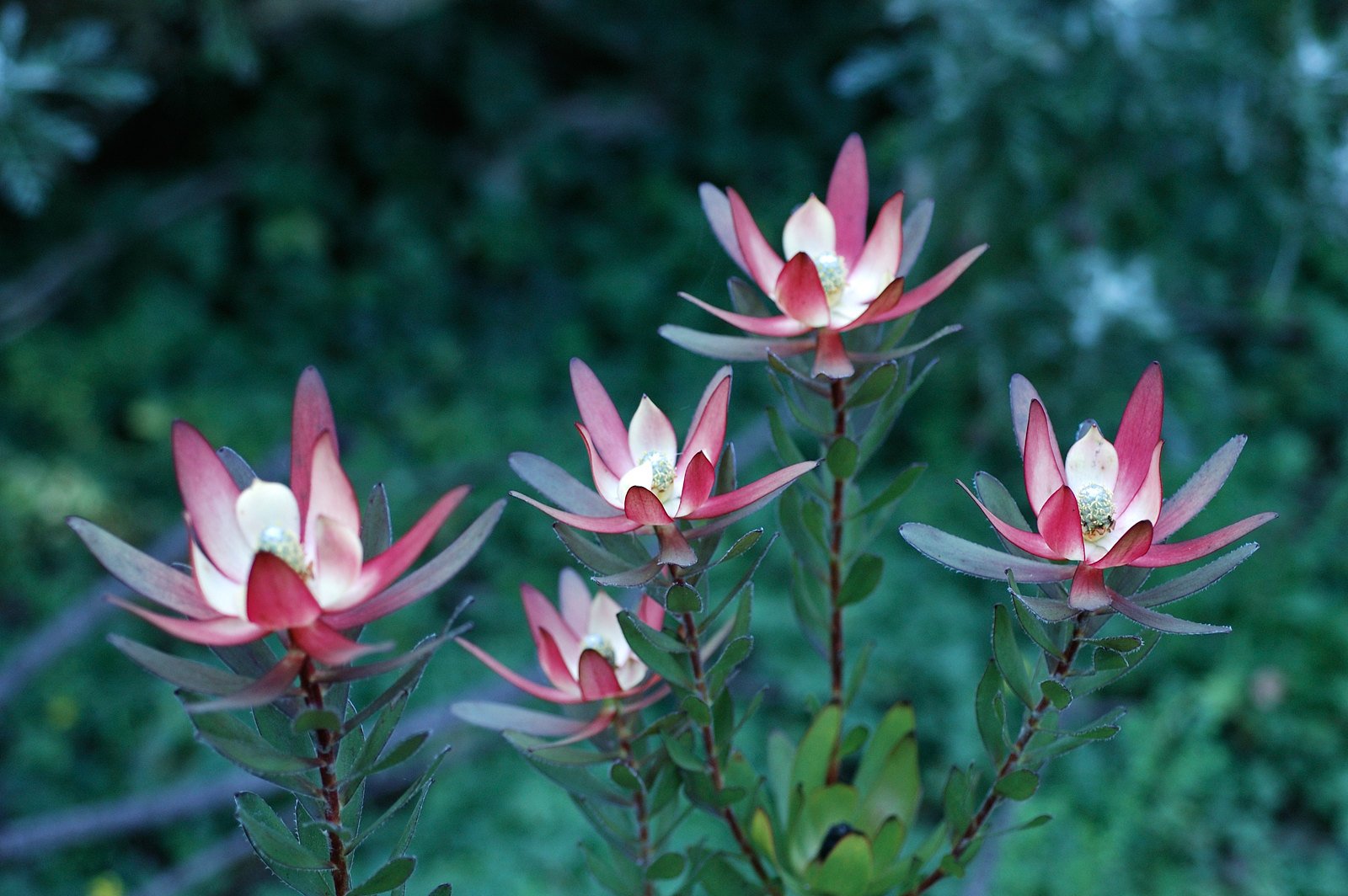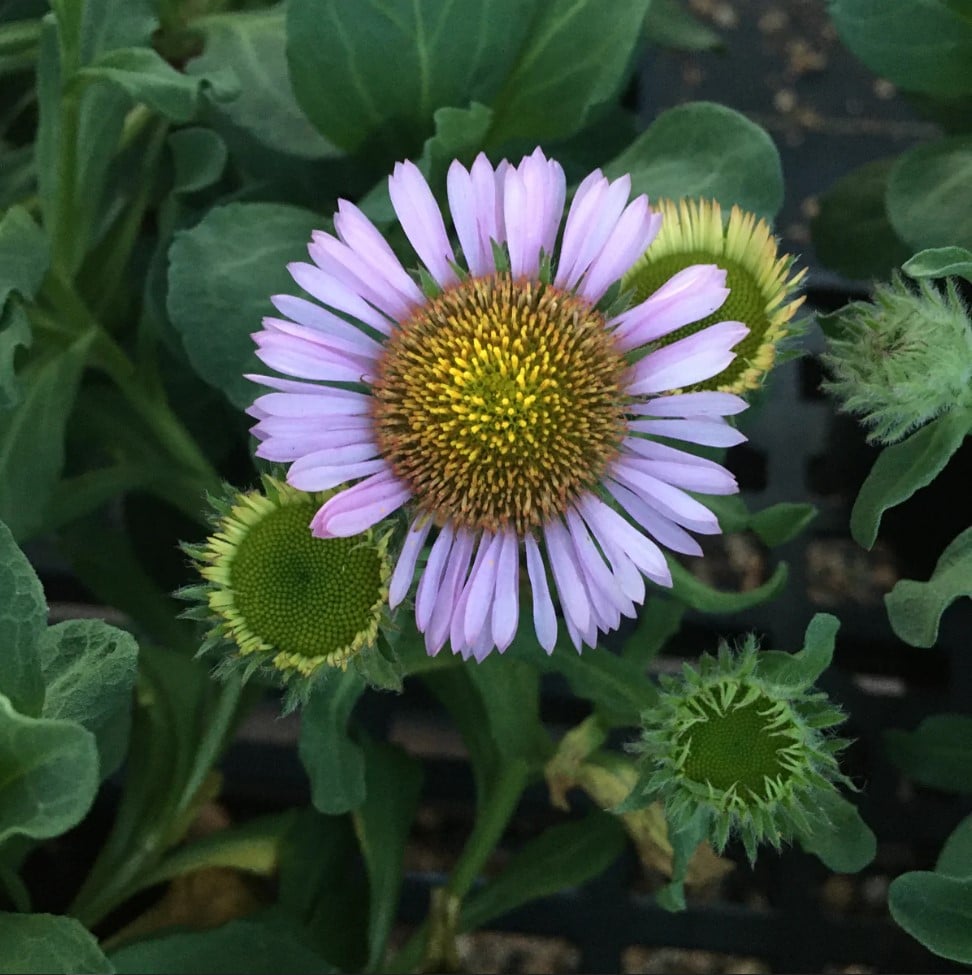Favorite Plants of
Pacific Plant People

Douglas Iris - Iris douglasania

Leucadendron 'Safari Sunset'
Seaside Daisy - Erigeron glaucus
Drought Resilient
Plant Family
Genus
Species
Seaside Daisy - Erigeron glaucus

Water Use
Once established, low to moderate depending upon conditions. May look sad during hot spells, but typically rebounds when rain or cooler temperatures return.
Conditions When It Thrives
Full sun, most soils. Requires good drainage.
Ecosystem Services
Supports multiple bees and butterflies.
Native To
California
Geographic Range
USDA Zones 4-9 Occurs in coastal bluffs and scrub below 500 feet from Santa Barbara County north to Oregon.
Availability
The species is carried by many nurseries, or erigeron can be grown from seed. Cultivars are also available.
Height & Habit
Up to 1’ tall and 2’ wide, trailing habit.
Special Features
Attractive to bees and hosts several butterflies and moths.


Also called fleabane, and seaside Daisy. Glaucus refers to the silvery-gray foliage, a common coastal plant adaptation.
Why They Love It
This long-blooming California native makes a great airy front-of-the border presence that delights humans as much as the many bees it attracts.
Seasonal Appearance/Dormancy
Blooms spring through summer with deadheading. Blue-green foliage is evergreen in winter but may go dormant in the heat of summer. Flower color can vary from lavender and blues to pinks or white that surrounds a central yellow-green disk.
Advice
Life span is typically two to seven years. Given bare ground and tending around original plants, erigeron can self-sow. Otherwise they will need replacing. They can be grown from seed and the seeds do not need any treatments.Cut back if foliage becomes lanky.
Douglas Iris - Iris douglasania
Drought Resilient
Plant Family
Genus
Species
Douglas Iris - Iris douglasania

Water Use
Low to moderate water use once established – prefers moist, cool conditions
Conditions When It Thrives
partial shade, moist, rich soils from sea level to about 3000 (typically below 350 feet in sun along the coast.
Ecosystem Services
Bumble bees love them.
Native To
Coastal regions of Central and Northern California and Southern Oregon
Geographic Range
USDA Zones 4-9
Availability
Can be found in many nurseries carrying native plants.
Height & Habit
Up to 2’ x 3’, fountain-shaped habit.
Special Features
Reported to be unpalatable to deer.


Native Californians plied cordage from the leaves, which they then used to make fishing nets, snares, and bags, some of which lasted as long as a hundred years.
Why They Love It
Flores says this is one of the sturdiest irises you can plant in the garden.
Seasonal Appearance/Dormancy
Evergreen foliage, spring blooms range from white to blue, lavender, and deep purple.
Advice
The best time to divide or transplant this iris is when white external roots start to form and after the first spring rains. Great in mixed borders, woodland or meadow gardens, this iris can also make a nice groundcover and do well underneath oaks.
Leucadendron 'Safari Sunset'
Drought Resilient
Plant Family
Genus
Species
Leucadendron 'Safari Sunset'

Water Use
Low to moderate water use once established
Conditions When It Thrives
Partial to full shade, moist, rich soils from sea level to about 3000 feet.
Ecosystem Services
Native To
South Africa
Geographic Range
USDA Zones 9-11
Availability
Can be found online
Height & Habit
Up to 6’ x 8’, can be pruned for hedging
Special Features
‘Safari Sunset’ won the Royal Horticultural Society’s Award of Merit and is beloved by florists for its straight stems and knockout red bracts.


Why They Love It
This drought-loving plant shows off in its red foliage and contrasting bracts.
Seasonal Appearance/Dormancy
Evergreen
Advice
Can be used as a specimen shrub or as a hedge. Like other members of Proteaceae family avoid high-phosphorus fertilizer.
Seaside Daisy - Erigeron glaucus
Drought Resilient
Plant Family
Genus
Species
Seaside Daisy - Erigeron glaucus

Water Use
Once established, low to moderate depending upon conditions. May look sad during hot spells, but typically rebounds when rain or cooler temperatures return.
Conditions When It Thrives
Full sun, most soils. Requires good drainage.
Ecosystem Services
Supports multiple bees and butterflies.
Native To
California
Geographic Range
USDA Zones 4-9 Occurs in coastal bluffs and scrub below 500 feet from Santa Barbara County north to Oregon.
Availability
The species is carried by many nurseries, or erigeron can be grown from seed. Cultivars are also available.
Height & Habit
Up to 1’ tall and 2’ wide, trailing habit.
Special Features
Attractive to bees and hosts several butterflies and moths.


Also called fleabane, and seaside Daisy. Glaucus refers to the silvery-gray foliage, a common coastal plant adaptation.
Why They Love It
This long-blooming California native makes a great airy front-of-the border presence that delights humans as much as the many bees it attracts.
Seasonal Appearance/Dormancy
Blooms spring through summer with deadheading. Blue-green foliage is evergreen in winter but may go dormant in the heat of summer. Flower color can vary from lavender and blues to pinks or white that surrounds a central yellow-green disk.
Advice
Life span is typically two to seven years. Given bare ground and tending around original plants, erigeron can self-sow. Otherwise they will need replacing. They can be grown from seed and the seeds do not need any treatments.Cut back if foliage becomes lanky.
Douglas Iris - Iris douglasania
Drought Resilient
Plant Family
Genus
Species
Douglas Iris - Iris douglasania

Water Use
Low to moderate water use once established – prefers moist, cool conditions
Conditions When It Thrives
partial shade, moist, rich soils from sea level to about 3000 (typically below 350 feet in sun along the coast.
Ecosystem Services
Bumble bees love them.
Native To
Coastal regions of Central and Northern California and Southern Oregon
Geographic Range
USDA Zones 4-9
Availability
Can be found in many nurseries carrying native plants.
Height & Habit
Up to 2’ x 3’, fountain-shaped habit.
Special Features
Reported to be unpalatable to deer.


Native Californians plied cordage from the leaves, which they then used to make fishing nets, snares, and bags, some of which lasted as long as a hundred years.
Why They Love It
Flores says this is one of the sturdiest irises you can plant in the garden.
Seasonal Appearance/Dormancy
Evergreen foliage, spring blooms range from white to blue, lavender, and deep purple.
Advice
The best time to divide or transplant this iris is when white external roots start to form and after the first spring rains. Great in mixed borders, woodland or meadow gardens, this iris can also make a nice groundcover and do well underneath oaks.
Leucadendron 'Safari Sunset'
Drought Resilient
Plant Family
Genus
Species
Leucadendron 'Safari Sunset'

Water Use
Low to moderate water use once established
Conditions When It Thrives
Partial to full shade, moist, rich soils from sea level to about 3000 feet.
Ecosystem Services
Native To
South Africa
Geographic Range
USDA Zones 9-11
Availability
Can be found online
Height & Habit
Up to 6’ x 8’, can be pruned for hedging
Special Features
‘Safari Sunset’ won the Royal Horticultural Society’s Award of Merit and is beloved by florists for its straight stems and knockout red bracts.


Why They Love It
This drought-loving plant shows off in its red foliage and contrasting bracts.
Seasonal Appearance/Dormancy
Evergreen
Advice
Can be used as a specimen shrub or as a hedge. Like other members of Proteaceae family avoid high-phosphorus fertilizer.

